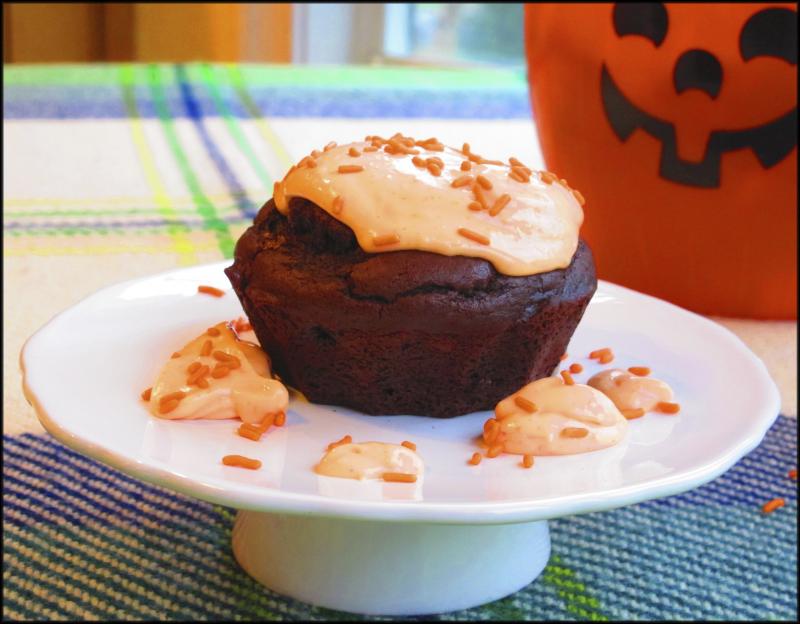Bundt cake can be any flavor you like; the name is about the pan
Since tomorrow is Halloween, I thought it would be fun to share a holiday-themed dessert. I was inspired by a photo online showing two miniature Bundt cakes, stacked so that their ridges aligned to resemble the outside of a pumpkin. They were topped with orange icing that looked suspiciously photoshopped and an inverted ice cream cone (colored green) inserted in the center for a stem.
I liked the miniature idea, slightly larger than a cupcake, but not as large as a full-sized cake. I also agreed with chocolate as the right flavor for the cake, so I was ready to start. One obstacle, however – no miniature Bundt pans in the cupboard. After a mad dash to the outlets, I returned with a cute set of four white porcelain pans.
For those of you unfamiliar with Bundt pans, they are round, with decorative designs on the sides and bottom (which becomes the top of the cake when it’s unmolded). There’s a raised cylinder in the center of the pan, which creates a depression in the top of the cake once it’s baked. The designs can range from simple lines to fruit motifs to still-life scenes.
The origins of the cake can be traced to northern Germany and the “bundkuchen” as well as the Eastern European “gugelhupf.” Food historians debate the source of the name “bund.” Some suggest it refers to the way the dough is bunched or bundled around the tube in the center, while others connect it to the cake’s appearance as a bundle or sheaf of wheat.
A transition from “bund” to “bundt” can be traced to the Nordic Ware cookware company in Minnesota. The owners were asked to create a modern version of the cast-iron gugelhupf baking dish. The result was a heavy cast-aluminum pan, initially manufactured in 1950 and named “Bundt” to trademark the design. Within 15 years, the pan developed wide popularity.
The first wave of interest in the pan occurred when the New Good Housekeeping Cookbook was published in1963, followed a few years later by the winning recipe for a Tunnel of Fudge cake at the annual Pillsbury Bake-Off contest. According to the Nordic Ware company, it has sold more than 60 million Bundt pans and the trademark is so strong, anything similar is simply called a fluted tube pan.
Although it has a name, there is no specific recipe associated with the Bundt cake pan. Because of the design, more of the batter directly touches the sides of the pan, allowing rich, dense cakes to cook evenly and completely without burning the edges or leaving the center uncooked. One common example is a pound cake, which is usually moister and denser baked in a Bundt pan than in a loaf pan.
The very features of the Bundt pan that make the cakes so lovely in design also make it imperative to completely and generously coat the inside before pouring in the batter. Either melted butter, hard shortening or non-stick cooking spray should be applied to coat every nook and cranny.
Another key is to allow the cake to cool slightly and begin to shrink away from the sides of the pan before attempting to unmold it. Finally, the toppings for a Bundt cake tend to be very delicate, so as not to overpower the rich flavor and texture. I’ve included recipes for the miniatures in the photo and another for the traditional version of pound cake, baked in a large Bundt pan.
Mini-Bundt Cakes
1 C flour
3/4 C brown sugar
1/2 C unsweetened cocoa powder
1/2 t baking powder
1/2 t baking soda
1/2 t salt (optional)
1/2 t cinnamon
1/2 C melted butter
1 t vanilla
1 egg, beaten slightly
1/2 C sour cream
1/2 C brewed coffee (cooled)
Preheat oven to 350 F. Completely coat the inside of 4 miniature Bundt pans with nonstick cooking spray; set aside. Stir together the dry ingredients in a large mixing bowl; set aside. In a small bowl, whisk together butter, vanilla, egg and sour cream. Add the liquid mixture and the coffee to the dry ingredients, and stir to combine thoroughly. Divide the batter evenly among the prepared pans. Bake until a cake tester comes out clean, about 25 minutes. Allow to cool for about 10 minutes, then invert pans to release cakes onto a cooling rack. Cool completely before frosting or dusting with confectioners sugar.
Traditional Pound Cake*
2 C butter, room temperature
2 C sugar
9 large eggs, room temperature
3 1/4 C flour
Preheat oven to 325 F. Coat the inside of a 10-cup Bundt pan with nonstick cooking spray; set aside. In the bowl of a stand mixer fitted with the paddle attachment, combine the butter and sugar, beating until light and fluffy. Add the eggs, one at a time, beating to incorporate before adding the next one. With the mixer on low, slowly add the flour, making sure the batter is completely smooth. Pour the batter into the prepared pan and bake until a tester comes out clean, approximately 90 to 95 minutes. If top begins to brown too quickly, tent with a piece of aluminum foil to prevent burning. Allow the cake to cool for at least 10 minutes before releasing onto a rack to cool. Serve topped with fresh berries or whipped cream. *Note: if weighed, each of the ingredients should approximate one pound; the eggs serve as the leavening agent in this recipe, which is why there is no baking powder or baking soda.
























































